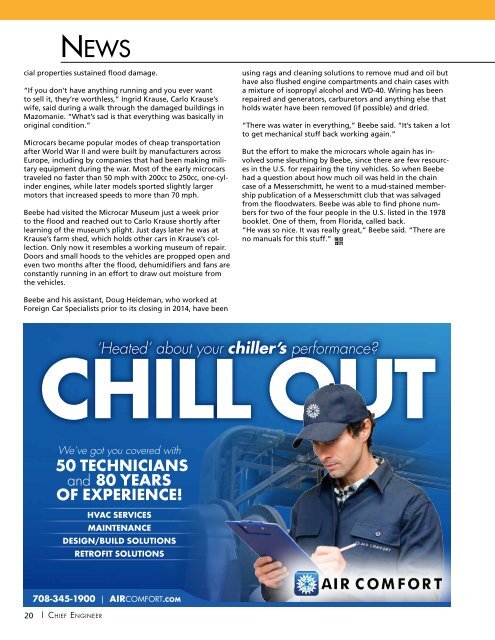Create successful ePaper yourself
Turn your PDF publications into a flip-book with our unique Google optimized e-Paper software.
NEWS<br />
cial properties sustained flood damage.<br />
“If you don’t have anything running and you ever want<br />
to sell it, they’re worthless,” Ingrid Krause, Carlo Krause’s<br />
wife, said during a walk through the damaged buildings in<br />
Mazomanie. “What’s sad is that everything was basically in<br />
original condition.”<br />
Microcars became popular modes of cheap transportation<br />
after World War II and were built by manufacturers across<br />
Europe, including by companies that had been making military<br />
equipment during the war. Most of the early microcars<br />
traveled no faster than 50 mph with 200cc to 250cc, one-cylinder<br />
engines, while later models sported slightly larger<br />
motors that increased speeds to more than 70 mph.<br />
Beebe had visited the Microcar Museum just a week prior<br />
to the flood and reached out to Carlo Krause shortly after<br />
learning of the museum’s plight. Just days later he was at<br />
Krause’s farm shed, which holds other cars in Krause’s collection.<br />
Only now it resembles a working museum of repair.<br />
Doors and small hoods to the vehicles are propped open and<br />
even two months after the flood, dehumidifiers and fans are<br />
constantly running in an effort to draw out moisture from<br />
the vehicles.<br />
Beebe and his assistant, Doug Heideman, who worked at<br />
Foreign Car Specialists prior to its closing in 2014, have been<br />
using rags and cleaning solutions to remove mud and oil but<br />
have also flushed engine compartments and chain cases with<br />
a mixture of isopropyl alcohol and WD-40. Wiring has been<br />
repaired and generators, carburetors and anything else that<br />
holds water have been removed (if possible) and dried.<br />
“There was water in everything,” Beebe said. “It’s taken a lot<br />
to get mechanical stuff back working again.”<br />
But the effort to make the microcars whole again has involved<br />
some sleuthing by Beebe, since there are few resources<br />
in the U.S. for repairing the tiny vehicles. So when Beebe<br />
had a question about how much oil was held in the chain<br />
case of a Messerschmitt, he went to a mud-stained membership<br />
publication of a Messerschmitt club that was salvaged<br />
from the floodwaters. Beebe was able to find phone numbers<br />
for two of the four people in the U.S. listed in the 1978<br />
booklet. One of them, from Florida, called back.<br />
“He was so nice. It was really great,” Beebe said. “There are<br />
no manuals for this stuff.”<br />
‘Heated’ about your chiller’s performance?<br />
CHILL OUT<br />
We’ve got you covered with<br />
50 TECHNICIANS<br />
and 80 YEARS<br />
OF EXPERIENCE!<br />
HVAC SERVICES<br />
MAINTENANCE<br />
DESIGN/BUILD SOLUTIONS<br />
RETROFIT SOLUTIONS<br />
The closed LTV Steel taconite plant is abandoned near Hoyt Lakes, Minn. The Minnesota Department of Natural Resources said Thursday, Nov. 1, <strong>2018</strong>,<br />
that it has issued permits to Poly Met Mining Inc. for a planned copper-nickel mine at the site. (AP Photo/Jim Mone, File)<br />
Divisive Minnesota Mine Wins Permits,<br />
But Faces Challenges By Jeff Baenen<br />
MINNEAPOLIS (AP) — Minnesota regulators on Thursday,<br />
Nov. 1, granted key permits to the long-planned PolyMet<br />
copper-mining project that’s opposed by environmentalists<br />
who fear it could someday foul waters, including Lake Superior.<br />
The state Department of Natural Resources issued permits to<br />
PolyMet Mining Inc. for the company’s proposed NorthMet<br />
project in northeastern Minnesota. The project still needs<br />
permits from other agencies, and likely faces court challenges.<br />
“No project in the history of Minnesota has been more<br />
thoroughly evaluated,” DNR Commissioner Tom Landwehr<br />
said in announcing approval of permits for the project, first<br />
proposed in 2004.<br />
Environmentalists have opposed the mine for fear it could<br />
pollute pristine waters and destroy habitat for gray wolves<br />
and Canada lynx. The project would be located near tributaries<br />
feeding the St. Louis River, 175 river miles upstream from<br />
Lake Superior.<br />
Duluth for Clean Water said the proposed mine “would<br />
create permanent, toxic pollution in the headwaters of Lake<br />
Superior, putting our communities and lives in constant<br />
danger.”<br />
(Continued on page 22)<br />
708-345-1900 | AIRCOMFORT.COM<br />
20 | Chief Engineer<br />
Volume 83 · Number <strong>12</strong> | 21


















